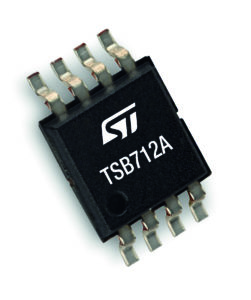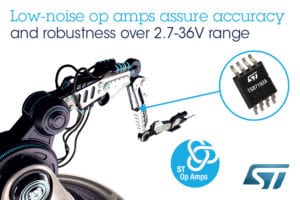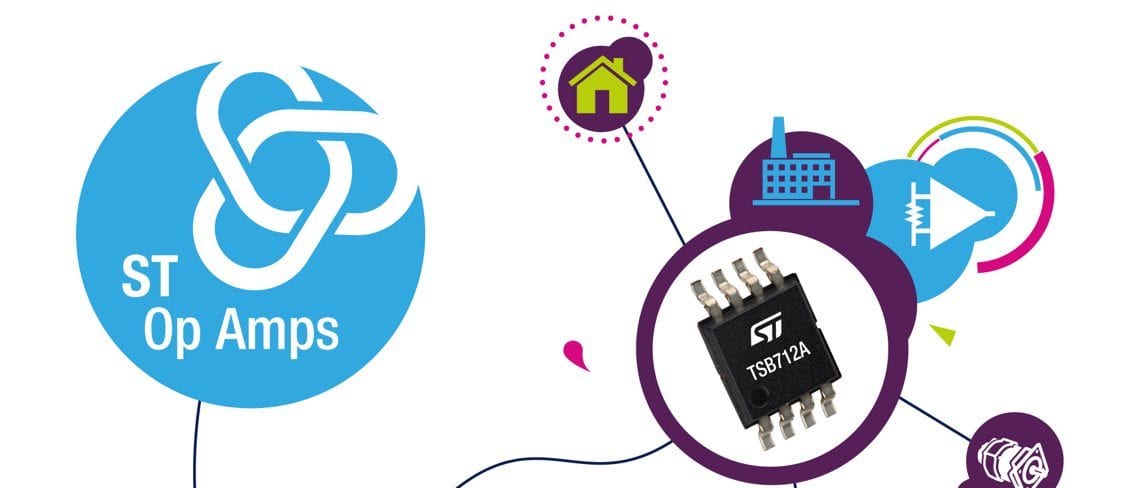The TSB712 and TSB7192 are our newest dual operational amplifiers (op-amps) that distinguish themselves thanks to a wide range of supply voltages (from 2.7 V to 36 V), as well as high speeds and a low input offset voltage, making them a choice component for current sensing applications in industrial settings, among others. The TSB712 has a rate of 6 MHz while the TSB7192 jumps to 22 MHz for designs that require a lot more bandwidth. Additionally, each model has a more precise alternative. The TSB712 and TSB7192 both have an input offset voltage of 800 µV while those that require even tighter performance can use the TSB712A and TSB7192A, which both have an offset voltage of only 300 µV. We are thus enabling engineers to choose the part that best fits their needs instead of forcing them to settle on a model with an inadequate feature set.
We understand that the right amplifier can have a tremendously positive impact on the overall design. Far from being a commodity, the correct part number can bring flexibility, efficiency, and robustness to a product, as we saw when we covered the TSU111, the most precise nano-power op-amp. As a result, we offer a powerful application on iOS and Android, ST op-amps, that can help engineers find the right component for their design, and we already updated the software to ensure that the new TSB712 and TSB7192 were available in all their variants. Indeed, as engineers work with increasingly stringent standards and regulations on power consumption, finding a fast and precise enough amplifier is no longer a luxury but a necessity, which is why we are launching these new models and ensuring engineers can easily find them in the ST op-amp app.
Two Input Offset Voltages and a Wide Range of Operating Voltage

Our new devices are compatible with a wide range of operating voltages that span from 2.7 V to 36 V thanks to its internal architecture that bypasses the limitations present on older BiCMOS components. As a result, companies don’t have to qualify multiple part numbers, thus making our new op-amps particularly pragmatic. It’s a detail that engineers can easily overlook, especially when they are just starting the prototyping phase, but having to qualify a lot of different parts can slow operations within an organization. Hence, having a component that qualifies for such a range of voltages means that engineers will be able to reuse it in a lot of their products, from current sensing for a 36 V battery to signal conditioning for environmental sensors.
Similarly, we also offer a more precise version of the two op-amps with an input offset voltage of only 300 µV (TSB712A and TSB7192A) to satisfy even more use cases. For a lot of situations, an input offset voltage of 800 µV is already excellent, and many will be more than content with it. However, when working with environmental or motion sensors, the voltage is so small that an input offset voltage of more than 500 µV could have a severely negative impact on performance and the quality of the information coming from the sensors. Hence, by offering much more precise devices, like the TSB712A and TSB7192A, engineers can amplify these small voltages with minimal errors.
Additionally, the input voltage drift is unusually low. The industry traditionally expects a similar competing component to offer around 5 µV/ºC whereas our devices only have a drift of 2.8 µV/ºC. Hence, our parts maintain a better precision over a wider temperature range.
Two Frequencies and a Robust Architecture For Dual Operational Amplifiers

We understand that there are a lot of different applications and use cases for our device, which is why we decided to offer two different frequencies. If engineers are designing a buffer, meaning that there’s only a gain of 1, then they can quickly turn to the TSB712 and its 6 MHz. On the other hand, if teams are dealing with a positive amplifier that uses a gain of 10 or more, or a negative amplifier with a gain of -9 or less, such as is often the case in a power supply, then the 22 MHz of the TSB7192 will ensure stable operations. Since the rest of the characteristics are identical, companies have the flexibility of using a component they already know well, which means designers can focus on other parts of their PCB without worrying about how our device will behave.
The type of applications that can welcome the TSB712 and TSB7192 are also numerous because the op-amps have versions that received an automotive-grade certification, thus testifying to the robustness and traceability of the architecture. Not every design will need such reliability, but the fact that our parts can pass the stringent tests associated with these standards is a guarantee in itself.
Additionally, we also included an Electromagnetic Interference (EMI) filter to make our solution even more robust. Indeed, current sensing applications for industrial motors deal with high voltages, which can lead to interferences. On the other end of the spectrum, our rail-to-rail input and output will be particularly valuable for low-power applications. At 2.7 V, for instance, a rail-to-rail architecture makes the design a lot simpler and efficient.
- Discover all the great features of the TSB712
- Check out what you can do with the TSB7192




